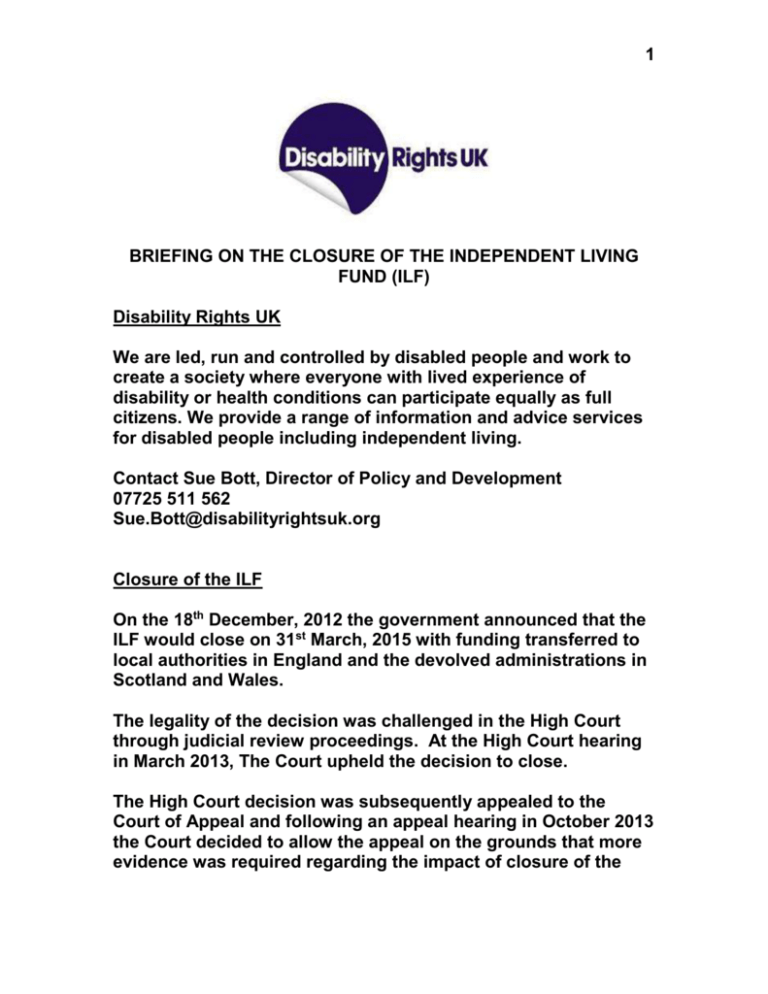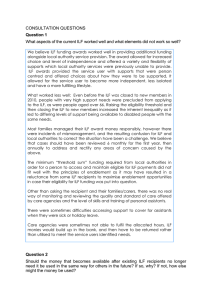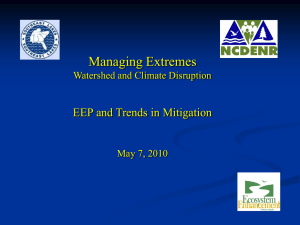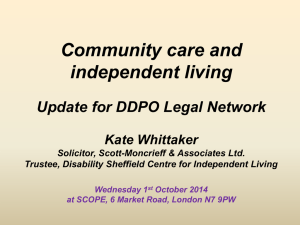ILF - Disability Rights UK
advertisement

1 BRIEFING ON THE CLOSURE OF THE INDEPENDENT LIVING FUND (ILF) Disability Rights UK We are led, run and controlled by disabled people and work to create a society where everyone with lived experience of disability or health conditions can participate equally as full citizens. We provide a range of information and advice services for disabled people including independent living. Contact Sue Bott, Director of Policy and Development 07725 511 562 Sue.Bott@disabilityrightsuk.org Closure of the ILF On the 18th December, 2012 the government announced that the ILF would close on 31st March, 2015 with funding transferred to local authorities in England and the devolved administrations in Scotland and Wales. The legality of the decision was challenged in the High Court through judicial review proceedings. At the High Court hearing in March 2013, The Court upheld the decision to close. The High Court decision was subsequently appealed to the Court of Appeal and following an appeal hearing in October 2013 the Court decided to allow the appeal on the grounds that more evidence was required regarding the impact of closure of the 2 fund on its users and that ministers had given due regard to the Public Sector Equality Duty. Following the undertaking of a new equality impact assessment, the Minister for Disabled People, Mike Penning announced in Parliament on 6th March 2014 that the ILF would now close on 30th June 2015.1 Funding for ILF users will be transferred to local authorities in England and the devolved administrations in Scotland and Wales according to the numbers currently using the ILF in that area. In June 2013 it was announced that the amount would be £262m for 2015/16. Three points to note: This amount is not ring fenced and therefore local authorities will be able to spend it according to local decision so not necessarily on current ILF recipients and others with the highest support needs and risks of loss of independence for those who have been protected by the ILF system. This funding is for one year only. There has been no announcement on future funding. The level of realterms cuts to local authority social care funding is such that the spending on services for disabled people will be drastically reduced overall, many times outweighing the addition of any funds transferred from ILF.2 Background to the ILF 1 2 http://www.dwp.gov.uk/ilf/news/ The Health and Social Care Information Centre states that the total number of people receiving social care services in 2012-13 was 1.3m, down 9% from 2011-12 and down 25% from 2007-08 (HSCIC, Community Care Statistics, Social Services Activity: England 201213, Provisional Release, 2013). This is the expected result of the targeting of cuts at local authority funding which will continue until at least 2015-16, suggesting a nearly 50% cut in social care provision by that stage. 3 The ILF was originally established in 1988 as a transitional fund to provide cash to support severely disabled people at home, and who were at risk of losing the value of domestic assistance allowances provided under the old supplementary benefits system.3 It is a non departmental public body funded by a grant from the Department for Work and Pensions. It operates as a discretionary trust, governed by a Trust Deed. The ILF currently makes cash payments to 18,000 disabled people to purchase care and support services or employ a personal assistant. The Fund set up in 1988 ran until 1993 when it was closed to new applicants and a new fund created. The two ran in parallel until 2007 when they were merged. The two funds had different eligibility criteria which has resulted in two different groups of users: Group 1 – pre 1993 users. There are about 2,800 in this group. Many of this group do receive some support in addition resources from the ILF but by no means all. It is not known how many in this group will meet the substantial and critical eligibility criteria as set out in the Care Bill. Group 2 – post April 1993 users. There are approximately 15,200 in this group. They have care packages that must include a local authority minimum contribution to their care package, currently £340 per week, and are very likely to have needs that are substantial or critical.4 In recent years eligibility for the fund has been tightened owing to financial pressures and government budgetary decisions. This has been exacerbated by a significant increase in applications. In March and April 2010 a total of 2,600 applications were received representing a 435% increase on the number normally expected for that time of year.5 The Trustees had to temporarily close the fund to new applicants in June, 3 Henwood M, Hudson B, 2007 Review of the Independent Living Funds, DWP DWP Equality Impact Assessment Independent Living Funds March, 2014 5 ILF letter to local authorities May, 2010 4 4 2010 because the budget for 2010/11 had been allocated. Finally, following a review, the Government decided to permanently close the ILF to new applicants as the model was ‘financially unsustainable’. The Impact of the Closure of the ILF on its Users In their response to the Government’s consultation on the closure of the ILF the Local Government Association and the Association of Directors of Adult Social Services stated: “As ILF recipients transfer into the LA system in 2015, and are subsequently reviewed against the local authority assessment criteria, the value of the personal budget calculated through the Resource Allocation System will generally be at a lower level than the initial ILF/LA budget.”6 It is likely that current ILF users will face a reduction in the funding available to them currently Those in group 1 (pre 1993) who have limited or no support from their local authority may find on transfer that their needs are assessed as low or moderate and therefore will not receive funding Some local authorities may take the view that restrictions on available funding will result in the offer being residential care rather than living in the community The Impact of the Closure of the ILF on the Care and Support System In recent years social care funding and expenditure has been reducing whilst the demand for support has been increasing. A recent report from the National Audit Office7 has highlighted: 6 7 Quoted in DWP Equality Impact Assessment Closure of the Independent Living Fund Adult Social Care in England: An Overview, National Audit Office March 2014 5 Local authorities total spending on adult social care fell 8% in real terms between 2010 – 2011 and 2012 – 2013 and is projected to continue falling Local authorities have reduced the amount of state-funded care provided through individual packages of care every year since 2008 – 2009 Demographic trends are creating additional financial pressures only mitigated in part by increased charges and self-funders. Added to this people of all ages who require support from local authorities have increasing high and complex needs.8 Although the number supported by the ILF is small in comparison to the total numbers supported by adult social care, the pressure on resources for local authorities will be exacerbated by the closure of the Fund particularly given that the overwhelming majority of ILF users are likely to come within the substantial and critical eligibility criteria. The closure of the ILF therefore has implications not just for ILF users but other users of local authority care and support. The Impact of the Closure of the ILF on Independent Living 90% of responses (1,700 – 1,800) to the Government’s consultation in 2012 on the proposed closure of the ILF came from individual ILF users and their families.9 A common concern raised was about inability to access social activities, voluntary work or employment because of the perceived reduction in people’s care packages. Two quotes from consultation responses given in the EIA illustrate the concern that the closure will result in not being able to take part in everyday activities as equal citizens that are the essentials of independent living: 8 Ayling R. Walden D. A Problem Share: Making Best Use of Resources in Adult Social Care, Towards Excellence in Adult Social Care (TEASC) and Think Local Act Personal (TLAP) 2013 9 DWP Equality Impact Assessment Closure of the ILF March 2014 6 “…people like me will end up sitting alone looking out of the window for most of the day unable to even go to the toilet. Until now, despite being severely disabled . . . and being unable to walk or use my hands or arms, I’ve been able to lead a fulfilling life . . . (without the ILF) I will be imprisoned at home, and will even have to give up my dogs.” “ILF allows me to do, as closely as possible, what normal human beings do, I do not do ‘activities’ or ‘access the community’ – I go out for a drive, for a picnic, to visit people, the kind of things ‘real’ people do.” In its report on the implementation of the right of disabled people to independent living published in March 2012 the Joint Committee on Human Rights expressed its concern for disabled people who could no longer apply to the ILF particularly with no alternative source of funding or any ring fenced funding. The Committee took the view that disabled people may be severely limited in being able to participate in society. They expected the Government to give consideration to alternative funding so as to ensure that rights enshrined in Article 19 of the United Nations Convention on the Rights of People with Disabilities (UNCRPD) were not breached.10 Although £262m will be transferred to local authorities and the devolved administrations in Scotland and Wales concern remains that funding is for 2015 – 2016 only and is not ring fenced. The Way Forward Disabled people are very unhappy about the decision by Mike Penning to close the fund. The decision has simply been repeated without fresh evidence being provided about the equality impact. The ILF is not perfect, and needs reform, but is the primary means for disabled people in the UK with the highest support needs to live independent lives in their 23rd report of session 2010 – 2012 Implementation of the Rights of Disabled People to Independent Living, Joint Committee on Human rights, House of Lords House of Commons 2012 10 7 communities. It levers additional and greater resources from Local Authorities and ensures their commitment and the quality of support. Demand may be growing but is easily limited through the Government’s budget. Closing the ILF is premature and savage without an alternative mechanism being put in place to ensure that Local Authorities continue to support inclusion rather than residential care for those with highest needs. It is the loss of the system that ILF represents that is at issue and is so catastrophic for those with the highest support needs. The risk is that local authorities will conclude that independent living is a luxury that can no longer be afforded. Given the closure of the ILF Disability Rights UK would urge the following to ensure disabled people are not denied their right to independent living as set out in the UNCRPD; and to ensure that the progress towards independent living that has been achieved over the past 30 years is maintained: a) The interdepartmental Ministerial Group on Disability chaired by Mike Penning, Minister of State for Disabled People discusses the implications of the closure of the ILF and the action that can be taken across government to ensure that the 18,000 users of the Fund and those who have been prevented from accessing the fund since 2010 are still included in society and able to realise their aspirations b) An undertaken is given that users of the ILF and disabled people in similar situations will not be consigned to residential care c) Local government to look at new ways of working and delivering adult social care so as to ensure that budget reductions are dealt with in a way that maximises the independent living of disabled people by working in partnership with others d) The NHS looks at how the provision of health in the community can be delivered in a way that maximises opportunities for independent living 8 e) Government undertakes further work towards a right to independent living and for all disabled people to be supported to overcome barriers that prevent us from leading ordinary lives in our communities Disability Rights UK March 2014










